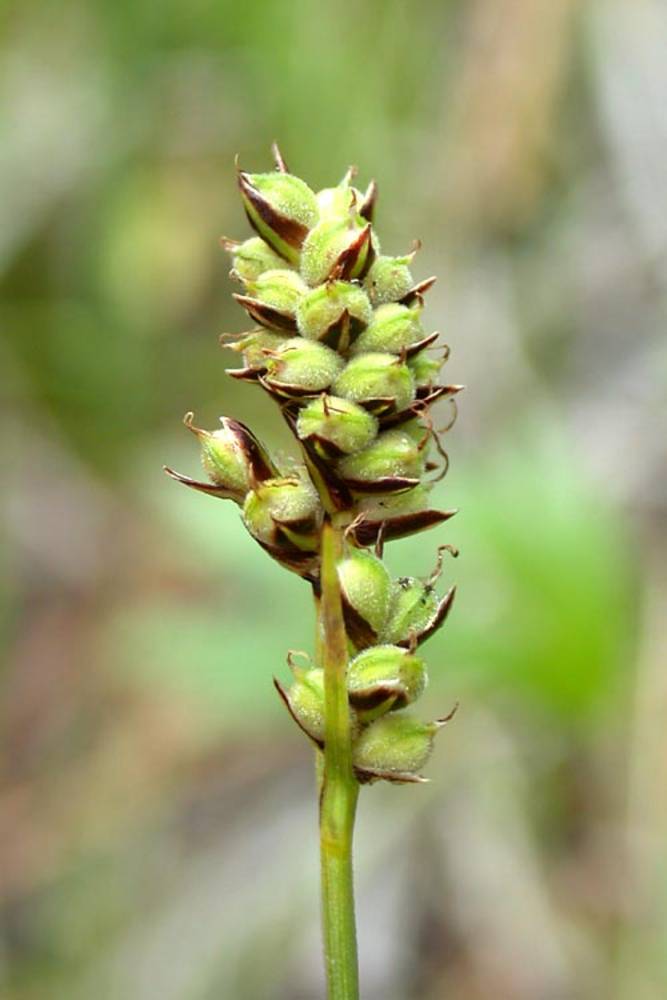
Plants dioecious or monoecious, rhizomatous, sometimes forming mats or rings; culms 8–40 cm tall, short and erect at anthesis, female flowering culms elongated in fruit and arching to the ground; plant bases purplish black.
Leaves (1.5)2.2–3.5(5) mm wide, green, usually longer than the culms, not papillose on the lower surface.
Inflorescences lowest bract usually bristle-like, usually shorter than the inflorescence; basal spikes none, or, if present, female and on elongated stalks; non-basal inflorescences male, female, or with lateral female spikes and one terminal male spike; solitary male spikes 1.1–2.4 cm long; sometimes with a small, infertile female spike at the base; lateral spikes female, 0–3, 0.6–1.1 cm long; solitary female spikes 1–1.5 cm long.
Female scales longer and narrower than the perigynia, purplish black, white-margined, with pale midrib.
Perigynia obovate, 3.1–3.6 × 1.5–1.8 mm, green, ripening tan or dark purple, pubescent, veinless except for the 2 marginal ribs (rarely with up to 5 veins to mid-length); beaks 0.5–1 mm long; teeth 0.2 mm long; stigmas 3.
Achenes globose-trigonous.
Serpentine savannas, in seasonally moist uplands, road ditches, abandoned roadbeds, dry creek terraces and edges of seeps. 50–1300 m. Est, Sisk. CA. Native.
Carex serpenticola is a short, upland species with pubescent perigynia and purplish black leaf sheaths and male and female scales, growing in serpentine savanna. It flowers in April or early May, and perigynia fall off by June. No similar species is normally dioecious. Compare to C. rossii and especially to C. concinnoides, which may grow with C. serpenticola and also has dark purplish black male and female scales, though its shoot bases are reddish brown.
as described under Carex serpenticola
Plants loosely cespitose or with solitary stems; rhizomes horizontal, purple to black, 25-75(-100) mm, slender. Culms 8-38 cm; bases (remnants of old leaves) weakly to strongly fibrous. Leaf blades green, 1.5-3.5(-5) mm wide, herbaceous, smooth to scabrous abaxially, smooth to scabrous adaxially. Inflorescences usually with either staminate or pistillate spikes, occasionally with both; peduncles of staminate spikes short; proximal nonbasal bracts leaflike, dark purple to black at base, shorter than inflorescences. Spikes: proximal pistillate spikes 1-4 (basal spikes 0-1); cauline spikes overlapping or somewhat separted, with 4-9 perigynia; staminate spikes 13-24 × (1.4-)2-4.1 mm. Scales: pistillate scales dark purple to black, with narrow white margins, lanceolate, 3.8-4.6 × 1.3-1.8 mm, apex acuminate; staminate scales oblanceolate, 4.6-5.6 × 1.1-1.6 mm, apex acute; proximal staminate scales with narrow white margins 0.1-0.2 mm wide. Anthers 2.1-4 mm. Perigynia green, occasionally dark purple in age, veinless or 5-veined near base, obovoid, 3.1-3.6 × 1.5-1.8 mm; beak slightly bent, dark purple, 0.5-1 mm, weakly ciliate-serrulate, apical teeth 0.2 mm. Stigmas 3. Achenes pale to medium brown, globose, round in cross section, 1.9-2.2 × 1.4-1.8 mm.Fruiting mid Apr-mid Jun. Open or partly shaded, vernally moist to wet meadows, riparian woodlands, savannas, successional scrublands, wetland margins, serpentine soils derived from ultramafic bedrock; 60-1200 m; Calif., Oreg.